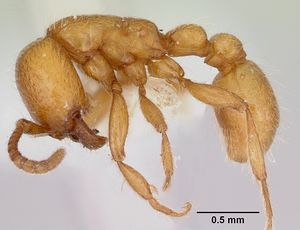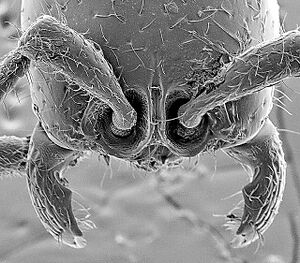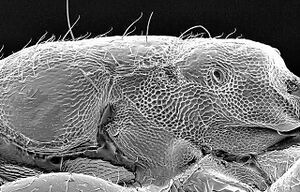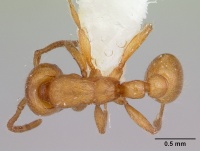Neivamyrmex wilsoni
| Neivamyrmex wilsoni | |
|---|---|

| |
| Scientific classification | |
| Kingdom: | Animalia |
| Phylum: | Arthropoda |
| Class: | Insecta |
| Order: | Hymenoptera |
| Family: | Formicidae |
| Subfamily: | Dorylinae |
| Genus: | Neivamyrmex |
| Species: | N. wilsoni |
| Binomial name | |
| Neivamyrmex wilsoni Snelling, G.C. & Snelling, R.R., 2007 | |
Known habitats include oak-pine-juniper woodland, chamise chaparral and coastal sage scrub. Specimens have been collected from under a rock. (Snelling and Snelling 2007)
Identification
Worker. Eye spot absent; front of head smooth and shiny, with scattered coarse punctures; subantennal lamella well developed; petiole longer than broad in dorsal view, sides anteriorly convergent; postpetiole distinctly wider than long, disc smooth and shiny, sides shiny and lightly sculptured. This small species is most similar to Neivamyrmex nyensis and may be confused with that species. It may be separated by the shorter antennal scape (3.0× as long as wide vs. 4.0× as long as wide) and the opaque mesosomal dorsum. The only other local species with which Neivamyrmex wilsoni might be confused is Neivamyrmex leonardi, but in that species the mandibular teeth are better defined and the postpetiole is twice as wide as long. N. wilsoni is also a more hairy ant than other similar species. Large workers are further characterized by having the lower two-thirds or three-fourths of the head weakly longitudinally strigulose. (Snelling and Snelling 2007)
Keys including this Species
Distribution
United States and Mexico.
Latitudinal Distribution Pattern
Latitudinal Range: 33.6° to 32.41666667°.
| North Temperate |
North Subtropical |
Tropical | South Subtropical |
South Temperate |
- Source: AntMaps
Distribution based on Regional Taxon Lists
Nearctic Region: United States (type locality).
Distribution based on AntMaps
Distribution based on AntWeb specimens
Check data from AntWeb
Countries Occupied
| Number of countries occupied by this species based on AntWiki Regional Taxon Lists. In general, fewer countries occupied indicates a narrower range, while more countries indicates a more widespread species. |

|
Estimated Abundance
| Relative abundance based on number of AntMaps records per species (this species within the purple bar). Fewer records (to the left) indicates a less abundant/encountered species while more records (to the right) indicates more abundant/encountered species. |

|
Biology
Castes
Only known from the worker caste.
Worker
Images from AntWeb
   
| |
| Worker. Specimen code casent0103465. Photographer April Nobile, uploaded by California Academy of Sciences. | Owned by LACM, Los Angeles, CA, USA. |
   
| |
| Worker. Specimen code casent0005337. Photographer April Nobile, uploaded by California Academy of Sciences. | Owned by UCDC, Davis, CA, USA. |
     
| |
| . | |
Nomenclature
The following information is derived from Barry Bolton's Online Catalogue of the Ants of the World.
- wilsoni. Neivamyrmex wilsoni Snelling, G.C. & Snelling, 2007: 492, figs. 16, 26, 48, 61, 74, 87 (w.) U.S.A. (California).
- Type-material: holotype worker, paratype workers (number not stated, “numerous”).
- Type-locality: holotype U.S.A.: California, San Diego County, Elliot Reserve, Mira Mar (32.84°N, 117.11°W), 28.iii.1996 (A. Suarez); paratypes with same data.
- Type-depositories: LACM (holotype); BMNH, CASC, LACM, MCZC, UCDC (paratypes).
- Distribution: U.S.A.
Unless otherwise noted the text for the remainder of this section is reported from the publication that includes the original description.
Description
Worker
measurements (mm) (n = 12). HL 0.48-0.77 (0.77); HW 0.36-0.70 (0.70); SL 0.24-0.0.405 (0.405); SW 0.07- 0.14 (0.14); PW 0.14-0.24 (0.24); PL 0.16-0.27 (0.27); PpL 0.12-0.23 (0.23); PpW 0.19-0.30 (0.30); HFL 0.34-0.62 (62) ; HFW 0.09-0.17 (0.17). Indices: CI 75-93 (90); FI 25-31 (28); SI 49-61 (52).
Head slightly longer than broad to distinctly longer than broad in minors, sides weakly convex; front of head smooth and shiny, with scattered coarse punctures; dorsolateral angle slightly developed, with strong preoccipital carina extending ventrad. Antennal scape about 2.9× longer than broad, evenly tapering toward base. Subantennal lamella well-developed. Mandible triangular, outer face weakly longitudinally striate; inner margin sharply angulate with masticatory margin, latter with small indistinct teeth.
Mesosoma contiguously punctate, slightly shiny. Promesonotal suture indistinct. Mesonotum smooth and shiny. Dorsum of propodeum opaque, in profile distinctly longer than slightly concave declivitous face. Petiole longer than broad in dorsal view and with sides convergent anteriorly, in profile dorsum evenly arched and abruptly descending anteriorly, disc shiny between sparse fine punctures; side punctate and opaque; subpetiolar process usually absent, but sometimes with small anteriorly directed tooth. Postpetiole distinctly wider than long, disc smooth and shiny, sides shiny and lightly sculptured.
Gaster smooth and shiny between small widely scattered punctures.
Pilosity about as usual in Neivamyrmex: a combination of sparse short to long, suberect to erect simple hairs.
Type Material
Holotype and numerous paratypes, U.S.A., California, San Diego Co., Elliot Reserve, Mira Mar (32.84° N 117.11° W), 28 March 1996 (A. Suarez). Holotype and most paratypes in Los Angeles County Museum of Natural History; paratypes also in The Natural History Museum, California Academy of Sciences, Museum of Comparative Zoology, and University of California, Davis.
Etymology
We name this species in honor of Ed Wilson, a small recognition of his many achievements in ant systematics, sociobiology and ecology.
References
- Snelling, G. C.; Snelling, R. R. 2007. New synonymy, new species, new keys to Neivamyrmex army ants of the United States. In Snelling, R. R., B. L. Fisher, and P. S. Ward (eds). Advances in ant systematics (Hymenoptera: Formicidae): homage to E. O. Wilson - 50 years of contributions. Memoirs of the American Entomological Institute 80:459-550. PDF
References based on Global Ant Biodiversity Informatics
- Snelling G. C. and R. R. Snelling. 2007. New synonymy, new species, new keys to Neivamyrmex army ants of the United States. Memoirs of the American Entomological Institute 80: 459-550

